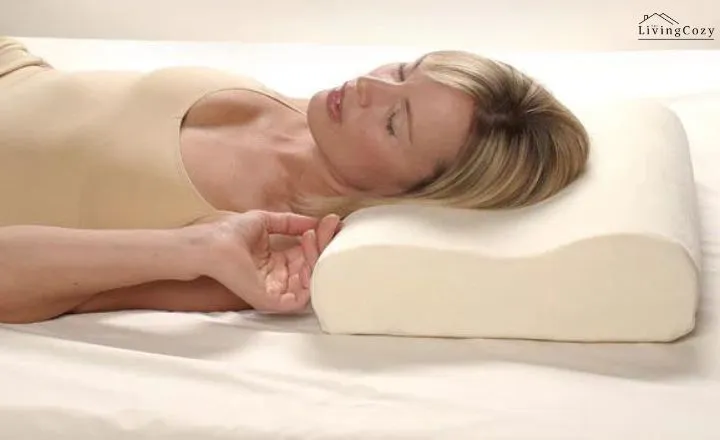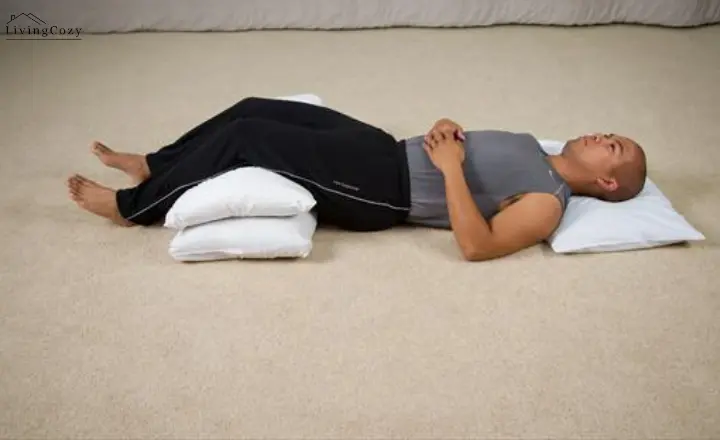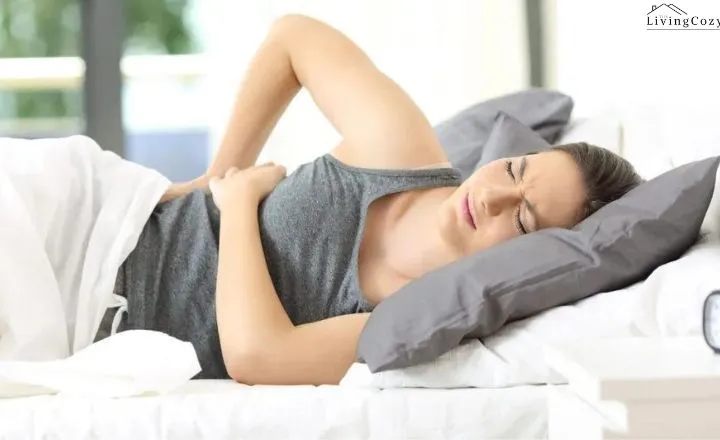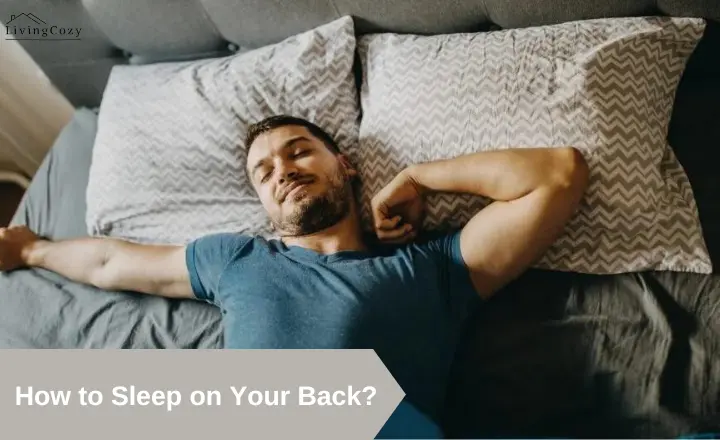Find that perfect sleeping position that allows us to drift off into dreamland comfortably. This article will dive deep into the realm of slumber techniques, focusing specifically on how to sleep on your back a position often recommended by experts for its numerous health benefits.
Below we will give you more information about How to train yourself to sleep on your back .so let’s start:
Sleep with your head and shoulders slightly elevated:
Sleeping with your head and shoulders slightly elevated can have several benefits, especially for those who suffer from certain health conditions.
It can help reduce symptoms of acid reflux or GERD (gastroesophageal reflux disease) as this position prevents stomach acid from flowing back into the oesophagus. It also aids in better breathing and can alleviate snoring or conditions like sleep apnea.
It’s important to note that the elevation should be done properly to avoid discomfort or other issues. Using multiple pillows might strain your neck or back. consider using a wedge pillow or an adjustable bed that provides a gentle incline.
Always consult with a healthcare provider before making significant changes to your sleeping habits, especially if you have underlying health conditions.
Find a pillow that contours to the curves of your neck and shoulders:

The best pillow that contours to the curves of your neck and shoulders is a memory foam pillow.
Memory foam pillows are designed to mould to the shape of your head, neck, and shoulders, providing optimal support and comfort. They help maintain the natural alignment of your spine while you sleep, which can reduce discomfort or pain.
Some popular brands for memory foam pillows include Tempur-Pedic, Coop Home Goods, and Casper. These companies offer a variety of shapes and sizes to fit individual needs.
For example, Tempur-Pedic’s Neck Pillow has an ergonomic design that provides proper alignment and support specifically for those who sleep on their back or side.
Sleep with an extra pillow beneath your knees:

Resting with a pillow placed beneath your knees aids in maintaining the natural curve of your back. It reduces lower back pressure, ensuring that your weight is evenly distributed and paving the way for enhanced spinal alignment.
This simple yet revolutionary bedtime habit could be a game-changer, offering surprising relief from persistent nocturnal nuisances like restless leg syndrome or sciatica pain.
Eat a light dinner:
There’s actual science supporting this ‘lighter dinner’ philosophy. It aligns seamlessly with our body’s natural rhythms; we burn more calories in daylight hours.
Therefore, having a predominately lighter meal at nighttime syncs with our metabolic rate leading to better digestion and energy utilization.
Society has ingrained in us that dinner should be the mightiest meal of the day; let’s unlearn that together and broaden our perspectives – we can feast like kings at breakfast and dine like paupers come sundown!
PICK THE RIGHT MATTRESS & PILLOW:
Choosing the right mattress and pillow largely depends on your personal comfort preferences, body type, and sleep habits. It’s important to consider factors such as firmness, material, size, and cost.
If you have back or neck issues, a medium-firm mattress might be best for you. Memory foam mattresses are popular because they conform to your body shape. For pillows, memory foam or latex pillows are recommended for those who suffer from neck pain.
Side sleepers may need a softer mattress and a thicker pillow to support their neck whereas back sleepers might prefer a firmer mattress with a thinner pillow. Stomach sleepers may find comfort in very thin pillows or no pillow at all.
Trying out different options in-store if possible before making a purchase is highly recommended so that you can find the combination that suits you best.
STRETCH BEFORE BED:
Stretching before bed can be very beneficial for both your physical and mental health. It can help to relax your muscles, increase flexibility, improve circulation, reduce stress and anxiety, and enhance sleep quality.
By incorporating a stretching routine into your bedtime routine, you may find that it helps to prepare your body and mind for a restful night’s sleep. Lower back and leg stretches can be beneficial if you’ve been on your feet a lot.
Gentle yoga poses like a child’s pose or a legs-up-the-wall pose can also be very calming before bed. Always remember to breathe deeply during each stretch to maximize relaxation.
Why Is Back Sleeping Uncomfortable for Some?

Back sleeping can be uncomfortable for some people due to a variety of reasons. common reason is related to the natural curvature of the spine.
When you sleep on your back, it can cause the lower back to arch excessively, leading to discomfort and potentially causing lower back pain. Using a supportive pillow or mattress can help alleviate this issue.
Sleeping on your back can exacerbate snoring and problems with conditions like sleep apnea because it allows gravity to pull down on the tongue and soft tissues at the back of the throat, obstructing the airway.
The Benefits of Sleeping on Your Back:
Sleeping on Your Back is a product designed to promote optimal sleep posture, offering numerous benefits to its users.
This product encourages the perfect alignment of your spine and neck during sleep which can significantly reduce back pain, improve circulation, and minimize wrinkles.
The product’s features focus on supporting the natural curvature of the spine and relieving pressure points, ensuring a comfortable night’s rest.
By reducing the risk of developing chronic conditions such as insomnia or sleep apnea, Sleeping on Your Back ensures you wake up feeling rejuvenated and refreshed every morning.
Conclusion for How to Sleep on Your Back:
learning to sleep on your back can significantly improve your health and sleep quality. It may take time to adjust to this new position, but the benefits of better alignment, reduced tension headaches, and fewer wrinkles and acne make it worth the effort.
Use aids like pillows to support you as you transition, ensuring a comfortable night’s sleep. consistency is key so keep trying until it becomes second nature.
FAQ’s:
Can you sleep on your back when pregnant?
Yes, you can sleep on your back when pregnant, especially during the first trimester.
As your pregnancy progresses into the second and third trimesters, it’s generally recommended to avoid sleeping flat on your back for long periods.
What is the best mattress for back sleepers?
The best mattress for back sleepers is typically a medium-firm mattress.
This type of mattress provides a good balance between comfort and support, which is crucial for maintaining proper spinal alignment.
Why can’t I fall asleep on my back?
Difficulty falling asleep on your back could be due to various reasons. One common cause is sleep apnea, a condition where breathing repeatedly stops and starts during sleep.
This condition often worsens when you sleep on your back because gravity can cause the tongue to fall back, blocking the airway.
What is the best Pillow position for back sleepers?
The best pillow position for back sleepers is to have a pillow that supports the natural curvature of your spine.
This means it should be flat enough to keep your neck aligned with the rest of your body, but not so flat that it doesn’t provide support.
A medium-firm pillow is typically ideal for this.
What percentage of back sleepers?
The percentage of people who sleep on their backs, also known as the supine position, varies greatly depending on the source.
it’s generally estimated that around 10% to 30% of adults are back sleepers.
What are the best pillows for back sleepers?
The best pillows for back sleepers are typically those that provide ample support for the neck and shoulders while maintaining a comfortable level of softness.
Memory foam pillows are often suggested as they contour to the shape of your head and neck, providing excellent support.
Brands like Tempur-Pedic and Coop Home Goods offer high-quality memory foam pillows that are well-regarded by back sleepers.
Is it good to sleep on your back without a pillow?
Sleeping on your back without a pillow can be beneficial for the spine, as it allows for the natural alignment and curvature of the neck and spine to remain unimpeded.


